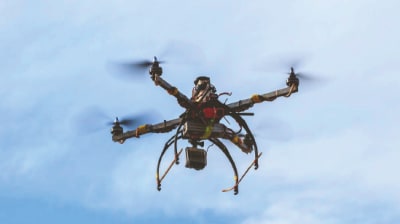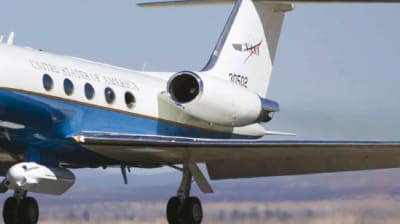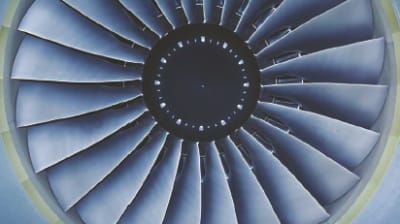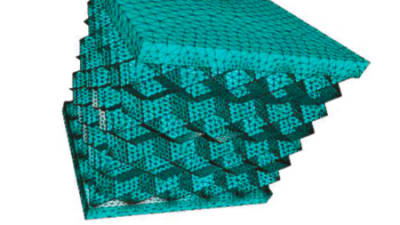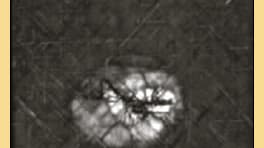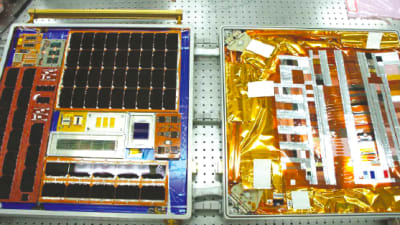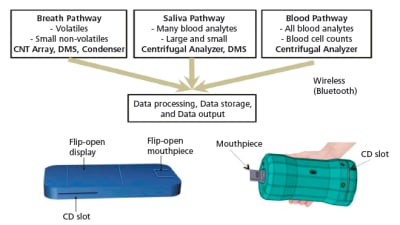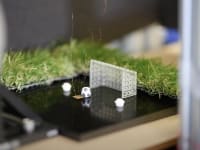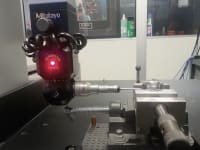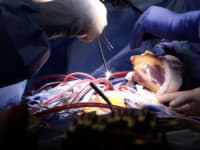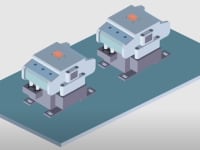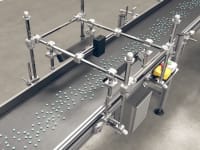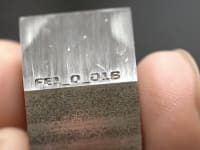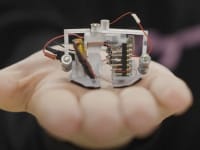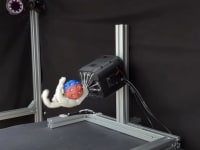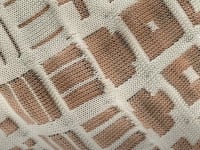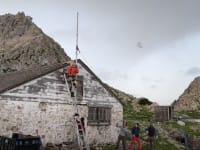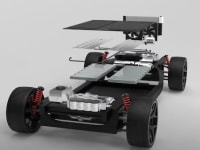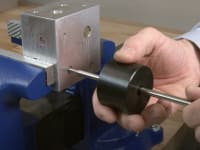61
169
-1
3480
30
Briefs: Information Technology
Auto-Coding Flight Software Hybrid Controllers Synthesized from Formal Specifications
The technique of synthesizing state-machine-based hybrid controller flight software (FSW) from formal specifications is demonstrated utilizing two simple controller examples (i.e. a simple thermostat and a simple autonomous vehicle). Formal requirements for these...
Briefs: Information Technology
Active Learning System for iPTF Candidate Classification
The Intermediate Palomar Transient Factory (iPTF) is a visible-spectrum astronomy survey aimed at detecting “transient” events such as supernovae. Every night, a telescope at the Palomar observatory collects images of various regions of the sky and compares them to a set of reference...
Briefs: Software
Cobra: an Extendable Tool for Interactive Code Analysis
Source code analysis typically requires the use of expensive and difficult-to-configure tools that support only a predefined set of standard checks. In some cases, it is possible to add customized checks, but doing so can be laborious and requires a deep understanding of each tool’s internal...
Briefs: Manufacturing & Prototyping
Quantum cascade (QC) lasers employ intersubband electronic transitions in semiconductor quantum well structures to generate emission at specific...
Briefs: Information Technology
Common Workflow Service: A Standards-Based Process Management System
As mission operations grow in scale and complexity, there is a prevailing need for automating operational processes to increase efficiency, mitigate risks, and reduce operational costs. The need for automating operational processes has produced a few disparate automation systems...
Briefs: Photonics/Optics
A Novel Orbiting Cloud Imager System for IR/UV/X-Ray Bands
Typically, the cost of a spaceborne imaging system is driven by the size and mass of the primary aperture. Innovative solutions for imagers that are less complex and are lightweight are very desirable. Currently, telescopes such as JWST and ATLAST are very expensive and very complex.
Briefs: Aerospace
Efficient and safe arrival operations under challenging traffic conditions are a key objective for air transportation modernization efforts taking place throughout the world. However,...
Briefs: Aerospace
NASA has developed a traffic management system for Unmanned Aerial Systems (UASs) to maintain safe and efficient UAS operations. This novel technology enables the growth in civilian applications of UAS...
Briefs: Aerospace
System and Method for Dynamic Aeroelastic Control
Innovators at NASA’s Armstrong Flight Research Center are developing a collection of algorithms that can accurately determine the structural state of an aircraft. This work is in response to new airframe designs that save weight — and thereby improve fuel efficiency — by removing stiffness in...
Briefs: Aerospace
This technology is a new type of aircraft pylon design for noise control. A pylon connects the engine to the airframe of an aircraft. This design uses air passing through the pylon to actively disrupt...
Briefs: Aerospace
Supporting Test Aircraft with Lift Airbags
Innovators at NASA’s Armstrong Flight Research Center have developed a method of using aircraft lift airbags to support test aircraft during wing strain gage load calibration. In calibration testing, a set of known loads is applied to the wing, and the loads and strain gage responses are then recorded....
Briefs: Aerospace
Enhanced Aircraft State Display for Improved Situation Awareness of Flight Envelope Limitations
In the case of an aircraft system failure such as control surface or engine failure, an aircraft’s flight envelope may change. Notifying the pilots of these changes may improve situational awareness and, hence, increase flight safety because pilots...
Briefs: Aerospace
Turbine film cooling flows typically are subject to jet detachment and reduced cooling effectiveness for high blowing rates. Current concepts to improve jet attachment involve impractical or overly complex hole designs due...
Briefs: Aerospace
Aeronautical Data Link and Radar Simulator (ADRS)
Air traffic management research needs to adequately address all players, including flight crews, air traffic controllers/managers, and airline dispatchers. Interactions between the different stakeholders are crucial elements for the viability of a given concept. A simulation capable of addressing...
Briefs: Aerospace
NASA has developed a versatile method and associated apparatus for constructing and using a conductive filament in various applications of 3D printing. It uses an attractive polymer formulation,...
Briefs: Manufacturing & Prototyping
NASA’s Langley Research Center has developed carbon fiber reinforced composites with self-healing properties. The initiation and propagation of damage to carbon...
Briefs: Manufacturing & Prototyping
Improved Impact Toughness and Heat Treatment for Cast Aluminum
NASA’s Marshall Space Flight Center researchers have developed a new, stronger aluminum alloy, ideal for cast aluminum products that have powder or paint-baked thermal coatings. With advanced mechanical properties, the NASA-427 alloy shows greater tensile strength and increased...
Briefs: Manufacturing & Prototyping
NASA’s Marshall Space Flight Center developed the handheld laser torch, designed for welding and brazing metals, to repair hard-to-reach Space Shuttle engine nozzles. It incorporates various manual...
Briefs: Materials
NASA seeks to license the Adaptive Thermal Management System (ATMS) for use in commercial applications. Developed at the John F. Kennedy Space Center, the ATMS provides a way to regulate heat transfer and...
Briefs: Materials
NASA’s Goddard Space Flight Center has developed a new method for bonding dissimilar materials using an elastic adhesive to permit the bond to withstand variations in temperature and pressure....
Briefs: Materials
The Johnson Space Center researched methods to coat aerogel insulation in order to make it better able to withstand vibration, mechanical compression and...
Briefs: Materials
Insulative Carbon Fiber Systems for Aerospace Applications
New insulative carbon-fiber composite systems have been developed for use in structural and thermal applications for the aerospace vehicle interface. The sandwich-type composite structure, including carbon fiber and aerogel blanket materials, is based on the previously disclosed family of...
Briefs: Medical
NASA’s Langley Research Center has developed ZONE, an innovative method for improving athletes’ responses to stress, anxiety, and loss of...
Briefs: Medical
NASA has developed a novel technology strategy called “The NASA Analyzer” that would provide comprehensive in-flight medical diagnostic capability in a compact, handheld device for human deep-space...
Briefs: Medical
Methods and Systems for Non-Invasive Treatment of Tissue Using High-Intensity Focused Ultrasound Therapy
Minimally invasive and non-invasive therapeutic ultrasound treatments can be used to ablate, necrotize, and/or otherwise damage tissue. High-intensity focused ultrasound (HIFU), for example, is used to thermally or mechanically damage tissue....
Briefs: Information Technology
NEQAIR v14.x Non-Equilibrium Radiative Transport and Spectra Program
There is a need to calculate the radiative heating rate at the surface of a vehicle entering any atmosphere, (e.g., Earth, Saturn, Titan, Mars, Venus etc). NEQAIR simulates the actual chemical and physical actions and reactions of the gaseous species in high-temperature shock...
Briefs: Information Technology
Systems Engineering Education and Development (SEED) Web Application
This application serves as Web-based management of the Systems Engi - neering Education and Development (SEED) program, and enables the SEED Program Manager to track and manage the applications and assignments. In the past, the handling of the applications and assignments was...
Briefs: Information Technology
Hammer 1.0
Many software applications have scripting needs including those based on the Goddard Mission Services Evolution Center (GMSEC) framework. In GMSEC, a user may want to automate the actions to take when a sequence of events occurs. Ideally, the scripting solution should allow the use of a familiar programming language and avoid unnecessary...
Briefs: Information Technology
Extended Testability Analysis (ETA) Tool V8.0
An assessment of a system’s safety requirements is required early in the design process when cost and time impacts are minimal. These requirements include fault detection, failure isolation, and failure recovery. Systems engineering groups at NASA have been exploring model-based products to better...
Top Stories
Blog: Manufacturing & Prototyping
2025 Holiday Gift Guide for Engineers: Tech, Tools, and Gadgets
INSIDER: Research Lab
Scientists Create Superconducting Semiconductor Material
Blog: Software
Quiz: Materials
Blog: Aerospace
Tech Briefs Wrapped 2025: Top 10 Technology Stories
Blog: Manufacturing & Prototyping
Webcasts
 Upcoming Webinars: AR/AI
Upcoming Webinars: AR/AI
The Real Impact of AR and AI in the Industrial Equipment Industry
 Upcoming Webinars: Motion Control
Upcoming Webinars: Motion Control
Next-Generation Linear and Rotary Stages: When Ultra Precision...
 Upcoming Webinars: Energy
Upcoming Webinars: Energy
Hydrogen Engines Are Heating Up for Heavy Duty
 Podcasts: Medical
Podcasts: Medical
How Wearables Are Enhancing Smart Drug Delivery
 Podcasts: Power
Podcasts: Power
SAE Automotive Podcast: Solid-State Batteries




